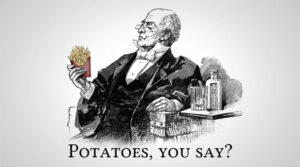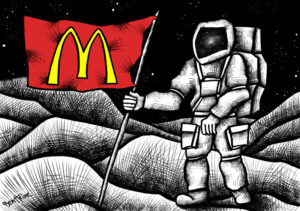All fast food restaurants provide deep-fried potatoes with the innocent-sounding signature of “French Fry,” yet these fries are probably not even French. Even if they do not call it that themselves, everyone in the globe is familiar with the snack. Despite the fact that the fried potato’s origins are not exactly American, it may be one of the most well-known American dishes available.
 Many civilizations like eating various types of fried potatoes. The French like Parisian steak fries, while the British prefer thick sliced chips. The cheese curds in Canadian poutine can cause just as much controversy as the mayonnaise-topped Belgian fries. But from where did they originate? Who was the French fry’s inventor? Why do they go by that name specifically?
Many civilizations like eating various types of fried potatoes. The French like Parisian steak fries, while the British prefer thick sliced chips. The cheese curds in Canadian poutine can cause just as much controversy as the mayonnaise-topped Belgian fries. But from where did they originate? Who was the French fry’s inventor? Why do they go by that name specifically?
What’s in the name?
French fries are just fried potatoes and are known by a variety of names around the world. They likely originated in Belgium or France. What is known is that the Francophone “pomme frites” or “fried potato” was likely the original version of the French fry. Historians believe that French fries could have been either a Belgian or a French dish.
Tracing the roots
According to historians, the Spanish brought potatoes to Europe, thus it’s possible that they invented their own style of fried potato. This comes as no surprise because it is commonly known that the potato originated in the “New World” or the Americas. The director of the Frietmuseum or “Fries Museum” in Bruges, Belgium, historian Paul Ilegems, notes that deep frying is a common practise in Mediterranean cooking, supporting the theory that the Spanish actually originated the idea of “French fries.”
 The Spanish dish patatas bravas, which features unevenly sliced home-style fries, may be the earliest example of French fries we know, though it obviously bears little resemblance to the ones we are accustomed to today.
The Spanish dish patatas bravas, which features unevenly sliced home-style fries, may be the earliest example of French fries we know, though it obviously bears little resemblance to the ones we are accustomed to today.
According to Belgian culinary historian Pierre Leqluercq, French fries were first mentioned in print in a Parisian book in 1775. He researched the origins of French fries and discovered the first recorded recipe for what is now a modern French fry in the French cookbook La cuisinière républicaine, published in 1795.
‘French’ Fries in America
Ironically, rather than the French, it is thought that the Americans, through their interactions with Belgians, popularised the fried potatoes known as “French fries.” When they first encountered the dish during World War I, they referred to it as French fried potatoes.
Since the Belgian army spoke French as a whole, not just the French soldiers, American soldiers coming in Belgium during the war concluded that the dish was French. Hence, they gave the meal the name French Fries. Since there are indications that it was known as French fries in English long before the American soldiers set foot on European soil, it is unclear how much of this tale is true. In cookbooks and journals during the 1890s, the phrase had progressively gained popularity even in America, but it is uncertain if the French fries described there were the modern-day fries or the thin, round fries that are now known as chips.
Conquering through McDonaldisation
No matter where this cuisine comes from, there is no doubt that America has left its mark on it. French fries are primarily associated with the US around the world. Every year, the average American consumes around 29 pounds of them.
 The term “McDonaldisation” was coined by American sociologist George Ritzer to describe a specific type of rationalisation of production, labour, and consumption that gained popularity in the late 20th century. The main notion is that these components have been modified to reflect the efficiency, calculability, predictability and standardisation, and control of a fast-food restaurant, and that this modification has repercussions on every part of society.
The term “McDonaldisation” was coined by American sociologist George Ritzer to describe a specific type of rationalisation of production, labour, and consumption that gained popularity in the late 20th century. The main notion is that these components have been modified to reflect the efficiency, calculability, predictability and standardisation, and control of a fast-food restaurant, and that this modification has repercussions on every part of society.
Fries in the products
Slowly, McDonaldisation shifted to the other industries as well. Various ‘American’ or rather the western food items appeared as a print on various Indian products. French Fries becomes the most celebrated print in various goods. Ranging from the stationary products to clothing and accessories, one would find those peppy prints of French Fries.
The furniture and wall embellishments have also overtaken the aesthetic art and are filled with the wall hangings of junk food. This slow and steady marketing of products has won the race. While you are constantly exposed to such prints, it definitely makes you crave for those items. You will move out to seek it or order it to satiate your tongue. Think about people who are not able to afford it (as they are sold at booming price), where will they go to gratify their desires?
























